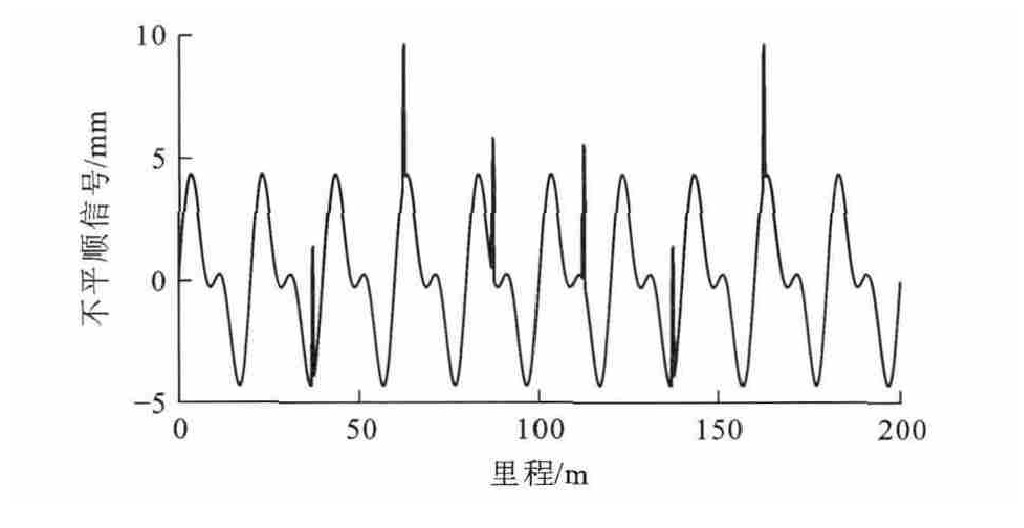Improved fuzzy method of removing abnormal spike data from track's geometric irregularity of high-speed railway
Article Text (Baidu Translation)
-
摘要: 根据高速铁路轨道几何不平顺毛刺异常值突然变化的特性, 设计了改进模糊消刺方法, 将差分突然增大或变小的点定义为毛刺异常值的起点, 将与起点相近的差分反向突然变化的点定义为毛刺异常值的终点, 选取包含毛刺异常值的最小区间的两个端点为插值点, 用其近似线性插值代替原来的毛刺异常值。按照单位分解原理构造隶属度函数, 并通过增加预判断, 避免数据点正常时计算向前差分、规则激发度量函数和模糊基函数。计算结果表明: 改进方法的计算精度与原模糊滤波方法相同, 但当计算长度大于500 km时, 计算时间小于原来的1/300, 它更适合在线实现; 利用改进方法对包含毛刺异常值的模拟轨道几何不平顺信号进行消刺处理, 滤波后的信号与解析信号的误差小于10-3; 利用改进方法不但能准确识别毛刺异常值的位置并自动修复, 而且能完整保留道岔处大轨距和大轨向等有用信息。Abstract: According to the mutation property of abnormal spike data for track's geometric irregularity of high-speed railway, an improved fuzzy method of removing abnormal spike data was designed.The point with unexpectedly increasing or decreasing forward difference was defined as the starting point of abnormal spike data, the following point being close to the starting point and with reversely changing forward difference was extracted as the end point of abnormal spike data, and the abnormal spike data were removed and replaced by the linear interpolation between the two endpoints of the minimum interval including the abnormal spike data.The membership functions were constructed by using the unit decomposition principle, and apre-judgment was proposed to avoid calculating the forward differences, the functions of firing degree of rules and the fuzzy basis functions when the track geometry data were normal.Calculation result shows that the improved method has the same accuracy as the previously used fuzzy filter method, but its computation time is less than 0.33% of the original one when the computation distance is longer than 500 km, so it is more easily achieved online.The errors between the analog signals and the measured track geometry irregularities are less than 10-3 when the improved method is used for detecting and removing the abnormal spike data.The improved method is able to not only accurately identify the locations of abnormal spike data andautomatically restore the signals, but also retain useful information such as the large alignments and gauges around the switches.
-
表 1 计算时间比较
Table 1. Comparison of computation times

-
[1] MADEJSKI J. Autonomous track geometry diagnostics system[J]. Journal of Materials Processing Technology, 2004, 157-158: 194-202. doi: 10.1016/j.jmatprotec.2004.09.029 [2] 柴东明, 魏世斌, 夏亮光, 等. 轨道状态确认车检测系统的研制[J]. 中国铁道科学, 2004, 25(1): 34-40. doi: 10.3321/j.issn:1001-4632.2004.01.006CHAI Dong-ming, WEI Shi-bin, XIA Liang-guang, et al. Research on measurement systems of track status confirmation car[J]. China Railway Science, 2004, 25(1): 34-40. (in Chinese) doi: 10.3321/j.issn:1001-4632.2004.01.006 [3] CHANDRA C, MOORE M S, MITRA S K. An efficient method for the removal of impulse noise from speech and audio signals[C]//IEEE. Proceedings of the 1998 IEEE International Symposium on Circuits and Systems. New York: IEEE, 1998: 206-209. [4] 王旌阳, 张潇, 朱俊敏, 等. 基于时频谱图的脉冲噪声抑制方法[J]. 振动与冲击, 2010, 29(2): 149-153, 192, 227. doi: 10.3969/j.issn.1000-3835.2010.02.034WANG Jing-yang, ZHANG Xiao, ZHU Jun-min, et al. Impulsive noise suppression based on time-frequency spectrogram[J]. Journal of Vibration and Shock, 2010, 29(2): 149-153, 192, 227. (in Chinese) doi: 10.3969/j.issn.1000-3835.2010.02.034 [5] ABREU E, LIGHTSTONE M, MITRA S K, et al. A new efficient approach for the removal of impulse noise from highly corrupted images[J]. IEEE Transactions on Image Processing, 1996, 5(6): 1012-1025. doi: 10.1109/83.503916 [6] CIVICIOGLU P. Removal of random-valued impulsive noise from corrupted images[J]. IEEE Transactions on Consumer Electronics, 2009, 55(4): 2097-2104. doi: 10.1109/TCE.2009.5373774 [7] ALIS A, MAN Hong, KHASHANAH K. Cascade windowbased procedure for impulse noise removal in heavily corrupted images[J]. Journal of Electronic Imaging, 2010, 19(1): 1-10. [8] SCHULTES, NACHTEGAEL M, WITTE V D, et al. Fuzzy impulse noise detection and reduction method[J]. IEEE Transactions on Image Processing, 2006, 15(5): 1153-1162. doi: 10.1109/TIP.2005.864179 [9] RUSSO F, RAMPONI G. A fuzzy filter for images corrupted by impulse noise[J]. IEEE Signal Processing Letters, 1996, 3(6): 168-170. doi: 10.1109/97.503279 [10] 范磊, 黄双华. 一种基于小波去噪的脉冲噪声抑制方法[J]. 舰船电子工程, 2008, 28(9): 104-106. doi: 10.3969/j.issn.1627-9730.2008.09.029FAN Lei, HUANG Shuang-hua. An impulse denoising algorithm based on wavelet denoising[J]. Ship Electronic Engineering, 2008, 28(9): 104-106. (in Chinese) doi: 10.3969/j.issn.1627-9730.2008.09.029 [11] MALLATS G. A theory of multiresolution signal decomposition: the wavelet representation[J]. IEEE Transactions on Pattern Analysis and Machine Intelligence, 1989, 11(7): 674-693. doi: 10.1109/34.192463 [12] YIN Lin, YANG Rui-kang, GABBOUJ M, et al. Weighted median filters: a tutorial[J]. IEEE Transactions Symposium on Circuits and Systems, 1996, 43(3): 157-192. doi: 10.1109/82.486465 [13] CHAN R H, HO C W, NIKOLOVA M. Salt-and-pepper noise removal by median-type noise detectors and detailpreserving regularization[J]. IEEE Transactions on Image Processing, 2005, 14(10): 1479-1485. doi: 10.1109/TIP.2005.852196 [14] ASTOLA J T. Performance analysis of the two-state signaldependent rank order mean filter[J]. Nonlinear Image Processing, 1999, 1(2): 56-66. [15] 刘金朝, 王卫东, 孙善超, 等. 铁路轨道几何数据冲击噪声小波-有序中值滤波方法[J]. 振动与冲击, 2014, 33(10): 29-33. https://www.cnki.com.cn/Article/CJFDTOTAL-ZDCJ201410006.htmLIU Jin-zhao, WANG Wei-dong, SUN Shan-chao, et al. Removing spike noise in railway track geometric data with a wavelet-rank order mean filter[J]. Journal of Vibration and Shock, 2014, 33(10): 29-33. (in Chinese) https://www.cnki.com.cn/Article/CJFDTOTAL-ZDCJ201410006.htm [16] ITAGAKI H. Improvements of nuclear magnetic resonance image quality using iterations of adaptive nonlinear filtering[J]. IEEE Transactions on Medical Imaging, 1993, 12(2): 322-327. doi: 10.1109/42.232262 [17] CHEN Tao, WU Hong-ren. Adaptive impulse detection using center-weighted median filters[J]. IEEE Signal Processing Letters, 2001, 8(1): 1-3. doi: 10.1109/97.889633 [18] AKKOUL S, LÉDÉE R, LECONGE R, et al. A new adaptive switching median filter[J]. IEEE Signal Processing Letters, 2010, 17(6): 587-590. doi: 10.1109/LSP.2010.2048646 [19] CHAN R H, HU C, NIKOLOVA M. An iterative procedure for removing random-valued impulse noise[J]. IEEE Signal Processing Letters, 2004, 11(12): 921-924. doi: 10.1109/LSP.2004.838190 [20] DI CLAUDIO E D, ORLANDI G, PIAZZA F, et al. An improved LS algorithm for the estimation of an impulsive noise corrupted signal by linear programming[C]//IEEE. Proceedings IEEE International Symposium on Circuits and Systems, 1991. New York: IEEE, 1991: 714-717. [21] NASO D, SCALERA A, AURISICCHIO G, et al. Removing spike noise from railway geometry measures with a fuzzy filter[J]. IEEE Transactions on Systems, Man and Cybernetics-Part C: Applications and Reviews, 2006, 36(4): 485-494. doi: 10.1109/TSMCC.2006.875422 [22] RUSSO F. Impulse noise detection and filtering using fuzzy models[C]//IEEE. Proceedings of the 17th IEEE Instrumentation and Measurement Technology Conference. New York: IEEE, 2000: 1041-1044. [23] ZHANG D, WANG Z. Impulse noise detection and removal using fuzzy techniques[J]. IEEE Electronics Letters, 1997, 33(5): 378-379. [24] BABUSKA I, MELENK J M. The partition of unity method[J]. Computer Method in Applied Mechanics and Engineering, 1997, 140(4): 727-758. [25] MELENK J M, BABUSKA I. The partition of unity finite element method: basic theory and application[J]. Computer Method in Applied Mechanics and Engineering, 1996, 139(1-4): 289-314. -





 下载:
下载:



























